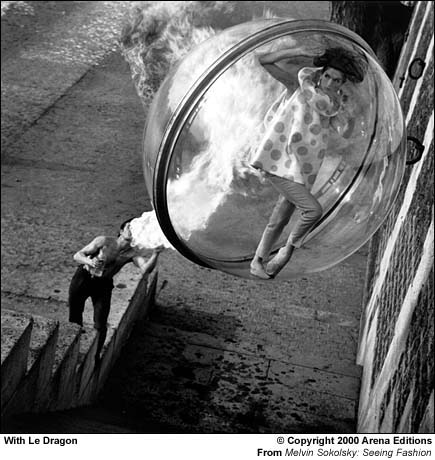 |
|
|
Melvin Sokolsky’s Affinities By Martin Harrison Like many of the talented individuals who operate in a high-powered, creative, but competitive environment, Sokolsky’s relationships with his colleagues at Harper’s Bazaar, were not always smooth. Of the art directors with whom he collaborated, he evidently found it much easier working with Henry Wolf ("He dared you to produce your best, he made you responsible.") than with his successor Marvin Israel ("Henry was the great catalyst, Marvin thought antagonism was a catalyst–he panicked you."). Among the fashion editors with whom he worked, he was personally ambivalent about the great Diana Vreeland, but admired both her sense of humor and the way she fought with the Editor-in-Chief, Nancy White, against compromise and censorship of the photographs: "Vreeland had this annoying posture of superiority, but she was fanatically committed to her work, whereas the best Nancy White could say about a picture was ‘It’s pretty’." He had to fight, too, for the models of his preference. When he discovered Donna Mitchell, for example, it took all of his persuasion to be allowed to take her to Paris, though once the resistance was overcome and the photographs were successful she was in demand from all quarters. Inevitably, and frustratingly for the photographer, some of his more unconventional ideas failed to reach publication. In retrospect, some of the killed sittings for Bazaar seem like mouth-watering gestures of defiance. Notable among these is the series of leatherwear he photographed on model Simone d’Aillencourt, her elegant hauteur in stark contrast to Sokolsky’s brutally realist location–the Coney Island D-train. He had tried to invoke the atmosphere of a Reginald Marsh painting, but on this occasion Diana Vreeland’s dismissive comment was merely "They are interesting pictures, but I can’t identify with where you have taken them." Even his gently satirical "Fourth of July" cover, in 1960 (page 65) was deemed too risqué for publication, though it was rescued from oblivion six years later to appear on the cover of the prestigious Swiss magazine, Camera. Of all Sokolsky’s work, the editorial fashion photographs received the broadest public recognition, since they were invariably published together with his by-line. Their extra visibility gives a misleading view of his entire output, for in fact more than three-quarters of his work was in the field of advertising: this is generally published without credits, and consequently the photographer remains anonymous. Though statistically a difficult claim to substantiate, it is likely that Sokolsky was the most successful advertising photographer of the 1960s. Certainly the huge amount of Art Directors Club Awards he received testifies to his high reputation. A major factor in his renown surely stemmed from his philosophy that it was dishonest for a photographer to deliberately turn down a notch, operating on a lower level for advertising assignments: "I resented the attitude that ‘This is editorial and this is advertising’. I always felt, why dilute it? Why not always go for the full shot?" Before the breakthrough onto Harper’s Bazaar, Sokolsky had spent about eighteen months working mainly on advertising campaigns. His first appearance in the Annual of Advertising and Editorial Art and Design, in 1958, was with a still-life of silverware, a refined and elegantly balanced composition, somewhat in the manner of his distinguished predecessor Leslie Gill; although Sokolsky’s tableau was placed in a Cornell-like box, both his and Gill’s still-lifes entered the lengthier tradition of the nineteenth-century American trompe l’oeil artists such as William Harnett. Reflecting on his career some years ago, Sokolsky told me that the most conducive sittings he undertook were photographing a still-life, a nude, or an untried new face. He was essentially a directorial photographer, and these tabulae rasa, which allowed him the optimum level of responsibility for all of the elements within the picture frame, presented a challenge he relished. Editorially, Sokolsky was a frequent contributor to many other magazines in addition to Harper’s Bazaar, including McCall’s (for which he photographed a complete one-man issue in October 1962), Ladies Home Journal, Esquire, Show, Newsweek, and the New York Times Magazine. Apart from fashion and still-lifes, he made many distinguished portraits for these magazines, and was frequently commissioned to photograph Hollywood celebrities. He once said that in a fashion image he wanted to photograph the human psyche, an ambition that enabled the transition to photographing an actor or actress to proceed quite smoothly. Some of his most enduring fashion photographs could equally be described as portraits (pages 72, 174) for example, stand comparison with the psychological perception of the portraits of Julie Christie or Mia Farrow (pages 55, 75 ). |
|
Order
the Seeing Fashion book
from the Arena Editions website. |